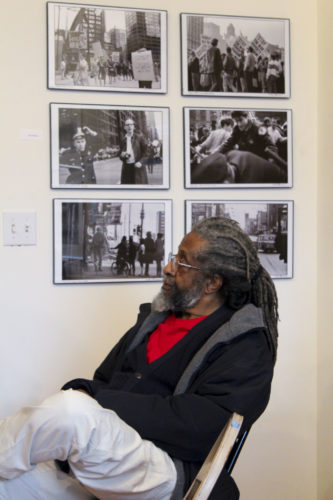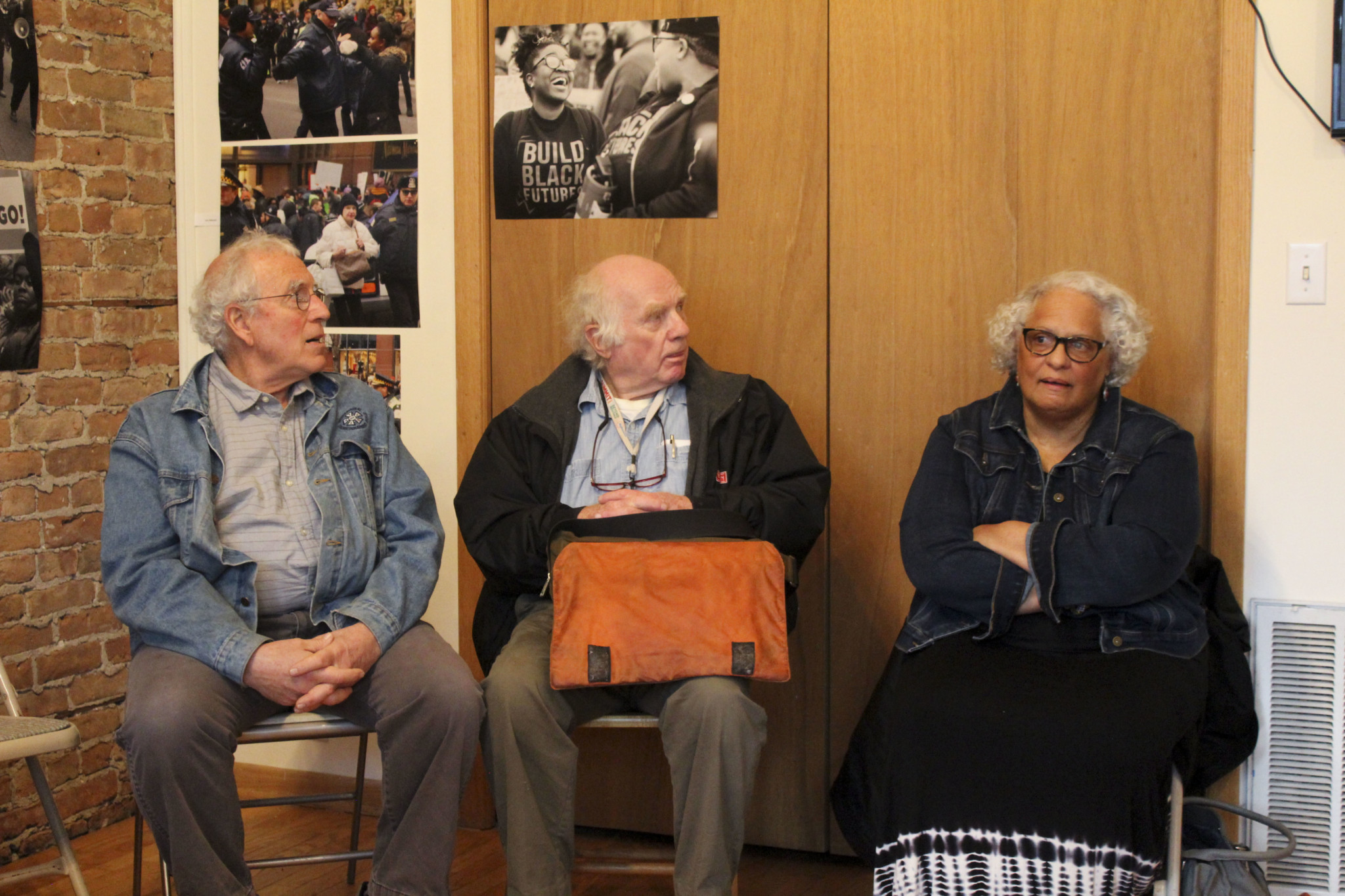Fifty years after the Kerner Report, are we going backwards? This is the underlying question of “April 1968 and Today: Police and Military Occupation of Chicago” at the Uri-Eichen Gallery in Pilsen, part of the gallery’s five-month series “Unfinished Business: 1968-2018.”
On its May 11 opening, over fifty individuals trickled in, filling the small, exposed brick room to capacity. The first thing they saw as they entered was a white plaque featuring an excerpt from the 1968 Kerner Report, written by the National Advisory Commission on Civil Disorders created after the 1967 Detroit race riots by President Lyndon B. Johnson and chaired by Illinois Governor Otto Kerner: “This is our basic conclusion: Our nation is moving toward two societies, one black, one white—separate and unequal. It is time to make good the promises of American democracy to all citizens.”
Through this frame, “April 1968 and Today” investigates the ways in which our society has remained—and perhaps grown further—unequal and unjust over the past fifty years. This examination of societal inequality began with the gallery’s visual art display.
One wall featured Gerard Evans’s photographs of Black organizers protesting in the Loop on Black Friday 2017 and after the Laquan McDonald video was released in 2015. Printed in grayscale and focused on communities of protestors, his photos have a striking capacity to convey their subjects’ emotion. When introduced and given the floor by gallery owner Kathy Steichen, Evans explained that his photography is dually driven by a passion for capturing activists’ energy and by a traumatic event of his youth.
“It was a long road to photography,” Evans said, adjusting his baseball cap. “It took me a long time to figure out what I liked shooting. When I first started, I was shooting portraits and stuff. I didn’t like that. And then I went to my first Trayvon Martin rally and I saw those images and they blew me away, and I said this is it. This is what I like shooting. So whenever I can, I attend events of civil disobedience, because there’s a certain degree of chaos in it, but there’s that unity of people coming together and accomplishing great amounts.”
“Another thing that factors into me enjoying doing this is that, in the ’70s, my best friend, who was the number one track star at Morgan Park High School, was shot right on the corner,” Evans continued. “And so when I think of all of these things, that’s what drives me.”
Next to Evans’s photographs were Larry Redmond’s from the same Black Friday march. Rendered in color and highlighting police-citizen relationships, Redmond’s work is stunning in the powerful statements it makes through the dichotomies it draws attention to. An activist since the Civil Rights Movement, Redmond now organizes with the campaign for a Civilian Police Accountability Council (CPAC), and uses his camera as a tool of civil disobedience.

“Cameras are absolutely weapons,” Redmond said. “Most photographers know that. So do the police. When we come into a demonstration and start turning our cameras at police… they will soften what they do because they don’t want to be portrayed as the animals they are. So yeah, cameras are weapons and I wield it like a weapon because I understand the power that it has.”
A departure from Evans’s and Redmond’s work, Kathy Weaver’s art—situated on the opposite wall of the gallery—features a fourteen-foot tall canvas depicting a mobile Eagle Eye police surveillance tower. With airbrush paint and stencil, Weaver depicts the contraption in detail that rivals the scrutiny she sees in surveillance at large.
“It’s an airbrushed piece about surveillance towers, and of course I stretched it so that it appears even more imposing,” Weaver said. “I’m doing a series of these, and the reason I’m doing them is because I think it’s just amazing that a portable device can be pulled up to any neighborhood and be used to spy on what citizens are doing.”
Beyond Evans’s, Redmond’s and Weaver’s work, the gallery displays an array of other art, including works by Marc PoKempner, Carlos Cortez, Nelson W Armour, Michael Kreuser, Peter Kuttner, Fareed Alston, co-founders Christopher Urias and Kathy Steichen, and more.
Though gallery guests seemed content to mull over the visual art all night, Steichen eventually corralled everyone into seats and initiated the panel discussion segment of the evening.
Moderating the panel was Peter Kuttner, a Kartemquin Films documentarian. He kicked off the discussion by explaining how April 1968 was a particularly memorable month of his life: he was jailed for three weeks after photographing the National Guard as it quelled the riots following Dr. Martin Luther King’s death. He also recalled how the Kerner Commission report had come out just a month before—and how, after King’s death, it had no effect, as the police chose to handle the rioting with violence.
“Everyone talks about the police going amok at the Democratic National Convention [in Chicago that year], but we [saw] the police going amok long before the convention,” Kuttner said. “And that’s why in May, we discuss that April.”
With that, Kuttner handed the mic over to his friend Bruce Thomas, who worked in 1968 as a Field Team Leader for the Kerner Commission.
“How did it happen that this presidential commission told the truth? Which is that ours is, has been, and continues to be a racist society? Strange as it sounds, no one had ever said that in the form of a government commission,” Thomas said.
“It says in the report very bluntly that in many cases police action either provoked the riots or compounded and worsened it,” he continued. “The report had a whole separate task force on police and it made a series of recommendations.… It was an effort to reach out to police departments across the country, so it did have some impact.”
But “it didn’t have much impact in Chicago,” Thomas continued, “because after the King assassination there was an explosion [of protest] in Chicago and the police went sort of berserk.”
Mary Scott-Boria, a lifelong activist, former Black Panther, and director of urban studies at the Associated Colleges of the Midwest, discussed what life was like living on the West Side during this month of rioting and police oppression.
“I was a seventeen-year-old,” she recalled. “I remember coming home from school. I was a teenage mother. I had my little baby. We were coming home on the Kedzie bus from school and heard the news that King had been assassinated.… And it was soon after the news broke, rioting happened up and down Kedzie. The worst was on Madison Avenue… that whole area up in flames. This was fifty years ago. What do I remember about fifty years ago? I remember the National Guard. I remember the National Guard coming into the neighborhood. I remember feeling sort of quarantined because we were told we couldn’t leave our homes for a few days.”
“My mother—who was a white woman—at the time, I thought she was probably the safest person in the neighborhood because they were there to protect her, not anyone who doesn’t look like her. So those were kind of the memories I have. They were there many days,” she said.

Scott-Boria used her time in the spotlight to shift the audience’s attention to the lasting impact of the 1968 riots on Chicago’s West Side. She explained how the neighborhoods never fully recovered from the damage inflicted during the riots because the city never helped the area to recover, instead pushing it further and further into disarray. All of this, she pointed out, indicates the fact that separate and unequal societies remain today the same as they did in 1968.
“People go through the West Side and they have no knowledge of what happened to the West Side,” she said. “The roots of a lot of what happened on the West Side are in this particular period.… So when you’re riding through and you’re seeing the ‘heroine highway’ along the expressway, think about why did they not, after the riots in ’67 and ’68, restore the West Side of Chicago?”
An audience member who identified himself as Mr. Skroger piggybacked off what Scott-Boria expressed about the West Side. He explained how when he was growing up in the West Side, there weren’t any serious gangs or drug problems, but that the police moved drugs into the neighborhood, which is what ultimately caused the neighborhood’s downturn.
“Back then you had [the 14th Street] Gypsy Clovers and you had Vice Lords,” Skroger recalled. “It was nothing. And then [the police] gave the gangs drugs. And when that got into picture, we all went haywire. When they broke our back right there, that was it… They knew what they were doing… When we burned Madison Street, Roosevelt, it took twenty to thirty years for them to even put anything there. We did it to ourselves, too, but we were angry. All we wanted to do is say, forget it, I’m finna get even, knowing we was tearing our neighborhood up all the time but right then we had to do what we had to do. We paid a big cost for that.”
Building off the accumulated energy in the room—at once downtrodden and fired up—folk singer Jesus “Chuy” Negrete closed the night with a rousing rendition of folk classic “Workers of the World Unite.”
Gallery guests sang along enthusiastically, and eventually began peeling out of the space, the lyrics “brown, red, black and white, all the workers must unite…” ringing loudly in their ears.
“April 1968 and Today: Police and Military Occupation of Chicago.” Open by appointment through June 1; there will be a closing program from 7pm–9:30pm on the same date featuring screenings and discussion. The “Unfinished Business: 1968-2018” series continues with the opening of “The Poor People’s Campaign: A National Call for Moral Revival” on June 8. Uri-Eichen Gallery, 2101 S. Halsted St. (312) 852-7717. uri-eichen.com
Maddie Anderson is a contributor to the Weekly. She last wrote about the artistic team behind the Obama Presidential Center in October.


Shows at this activist gallery are designed to teach us about our history and provoke discussion about current events and conditions. Sounds like they are succeeding on both fronts!
Great report on what sounds like an interesting and emotional event! I wish I’d been able to be there, but the article helps me feel that I was!
Your design is lovely, the writing is appreciated! and if you want help improving on the terrible photos you published, feel free to contact me..
the portrait of Larry Redmond in front of my pictures is especially awkward..
but really, mainly, THANKS for writing about the show!